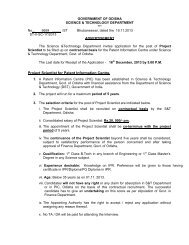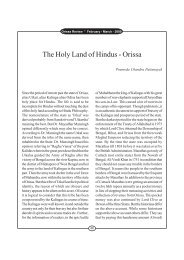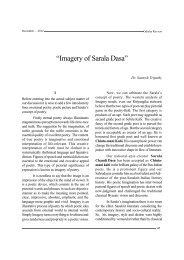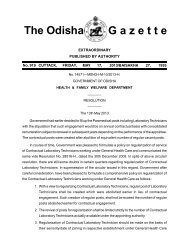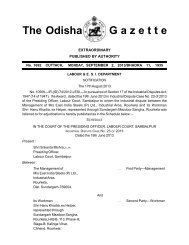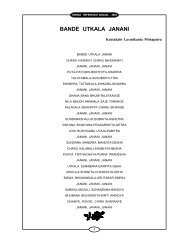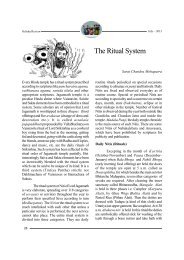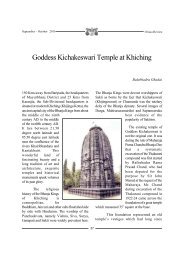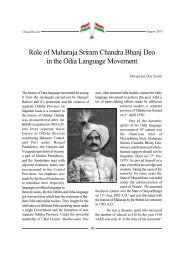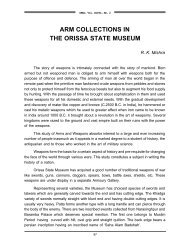Narasimha Temple at Puri
Narasimha Temple at Puri
Narasimha Temple at Puri
You also want an ePaper? Increase the reach of your titles
YUMPU automatically turns print PDFs into web optimized ePapers that Google loves.
Introduction<br />
The temple of <strong>Narasimha</strong> is one of ancient<br />
Vaishnava Shrines of <strong>Puri</strong>. It is situ<strong>at</strong>ed near the<br />
northeast boundary wall of the famous Gundicha<br />
temple. The shrine is found mentioned in the<br />
Skanda Purana to be existing while Indradyumna<br />
had visited the place. 1 Indradyumna is st<strong>at</strong>ed to<br />
have built a temple for <strong>Narasimha</strong> and to have<br />
installed the deity therein with the help of sage<br />
Narada. 2 Pandita Surya Narayan Das has also<br />
referred th<strong>at</strong> before the emergence of Ch<strong>at</strong>urdha<br />
murtis, king lndradyumna had installed this God<br />
and performed thousands of Asvamedha yajnas<br />
in this place (<strong>Narasimha</strong> temple). 3 For this reason,<br />
this <strong>Narasimha</strong> is popularly known as Yajna-<br />
<strong>Narasimha</strong>. 4 An elev<strong>at</strong>ed place has been levelled<br />
for erection of the main temple and its two front<br />
apartments. The surface of the temple complex is<br />
about 3 feet high from the road level. The area<br />
around the temple complex has been enclosed<br />
by high masonry walls with provision of a series<br />
of steps for entry into the premises of the western<br />
side. The temple faces to west.<br />
Architectural fe<strong>at</strong>ures of the temple:<br />
The temple of <strong>Narasimha</strong> consists of three<br />
structures such as the Vimana, the Jagamohana<br />
and the N<strong>at</strong>amandapa. The main temple is a<br />
Panchar<strong>at</strong>ha Rekha deula, which is fronted by a<br />
pyramidal Jagamohana and a rectangular<br />
Orissa Review July - 2010<br />
<strong>Narasimha</strong> <strong>Temple</strong> <strong>at</strong> <strong>Puri</strong><br />
72<br />
N<strong>at</strong>amandapa. All the structures within the<br />
premises are thickly plastered in lime mortar and<br />
painted in colours. The temple is built in sand<br />
stones, locally called as Baulamala p<strong>at</strong>hara.<br />
A. Vimana<br />
The Vimana of the <strong>Narasimha</strong> temple is<br />
a Panchar<strong>at</strong>ha Rekha deula and its height is about<br />
60 feet from the ground of the temple. 5 Dr. B.K.<br />
R<strong>at</strong>h has mentioned th<strong>at</strong> the height of the temple<br />
is about 35 feet from the surface of the temple<br />
complex. 6 The structure of the Vimana has four<br />
vertical divisions viz. pistha or plinth, bada or wall,<br />
Gandi or sikhara and mastaka. The base of the<br />
structure is square of 17 feet on each side. The<br />
Vimana is raised on a high plinth of 4 feet. There<br />
are no decor<strong>at</strong>ive elements in it. The bada of the<br />
Vimana is panchanga type i.e. having five<br />
component parts such as pabhaga, talajangha,<br />
bandhana, upper jangha and baranda. All the<br />
component parts of the bada are devoid of<br />
decor<strong>at</strong>ive ornament<strong>at</strong>ions except the baranda<br />
which contains three jhapasimhas: one on each<br />
side of the southern, eastern and northern of the<br />
Vimana respectively.<br />
Parsvadev<strong>at</strong>as:<br />
R<strong>at</strong>nakar Mohap<strong>at</strong>ra<br />
The three sides central niches of the bada<br />
of Vimana house the images of Varaha, Trivikrama<br />
(Vamana) and Vishnu as the Parsvadev<strong>at</strong>as of the<br />
main presiding deity. The Parsvadev<strong>at</strong>as are
housed with small nisha shrines projecting out from<br />
the walls. The image of Varaha is the Parsvadev<strong>at</strong>a<br />
of the southern side. The four handed image of<br />
Varaha is installed in standing pose holding the<br />
uplifted left arm of Prithivi with his major right<br />
hand and then hoisting her up on the elbow of his<br />
left upper hand. He holds Chakra in his uplifted<br />
back right upper hand while his lower left hand<br />
holds a conch above Goddess Prithvi. The right<br />
lower hand of deity is completely broken. The<br />
backside head of the deity is relieved with a fullblown<br />
lotus flower with stalk. A nagi figure with<br />
hands in anjali mudra is carved on the pedestal<br />
r<strong>at</strong>her than between the legs of Varaha in<br />
conventional manner. Two flying apsara figures<br />
are carved on the both sides top corners of the<br />
slab. They display flowers and garlands in their<br />
hands. The background slab of deity is decor<strong>at</strong>ed<br />
with trefoil makara head arch crowned by the<br />
kirtimukha motif.<br />
The Parsvadev<strong>at</strong>a on the northern side<br />
niche is Trivikrama or Vamana. The four handed<br />
image of Trivikrama has been installed on the double<br />
petalled lotus pedestal. He holds gada in right upper<br />
hand, lotus flower in right lower hand, chakra in<br />
left upper hand and conch in left lower hand<br />
respectively. Figures of Sridevi and Bhudevi are<br />
flanked on either side of deity. The right leg of deity<br />
is set firmly on the ground and another uplifted left<br />
foot touches the image of Brahma. Bene<strong>at</strong>h his<br />
uplifted leg is a scene of Bali who is presenting the<br />
gift to Vamana while Sukracharya lifts his hands up<br />
in dismay. The backside head of the deity is<br />
decor<strong>at</strong>ed with trefoil Makara head arch, which is<br />
surmounted by the Kirtimukha motif. There is a<br />
Vidyadhara figure depicted on the right side top<br />
corner of the slab. Prof. K.S.Behera and T.E.<br />
Donaldson have referred th<strong>at</strong> the image can be<br />
d<strong>at</strong>ed to the l<strong>at</strong>e 13th century AD. 7<br />
The image of Vishnu is the Parsvadev<strong>at</strong>a<br />
of the eastern or backside central niche of the<br />
bada. The four handed image of Vishnu has been<br />
Orissa Review July - 2010<br />
73<br />
installed on the double petalled lotus pedestal.<br />
According to Prof. T.E. Donaldson, the image<br />
on the backside central niche is Vishnu r<strong>at</strong>her than<br />
<strong>Narasimha</strong> who is enshrined in the sanctum. 8 Old<br />
priests of the temple trace it as the image of<br />
Narayana. Here the image of deity assumes a<br />
Samabhanga pose. He holds gada and lotus in<br />
his upper two hands, which are uplifted in a<br />
symmetrical fashion. The lower two hands are<br />
completely broken. Sridevi and Bhudevi are<br />
flanked on either side of deity with holding flowers<br />
in their hands. The background slab of the deity<br />
is decor<strong>at</strong>ed with trefoil makara head arch and<br />
the Kirtimukha motif <strong>at</strong> the apex. Two flying<br />
apsara figures are depicted on the both side top<br />
corners of the slab. On the basis of sculptural<br />
fe<strong>at</strong>ures, R.P. Mohap<strong>at</strong>ra has referred th<strong>at</strong> all the<br />
Parsvadev<strong>at</strong>as of <strong>Narasimha</strong> temple are the<br />
workmanship of the early medieval period. 9<br />
The curvilinear superstructure is<br />
surmounted on the gandi of Vimana. It displays<br />
five pagas or pilasters to outwards. The gandi of<br />
the main shrine is bereft of figure sculptures and<br />
decor<strong>at</strong>ive designs except however the projecting<br />
lions on central raha paga of all directions. Other<br />
four pagas are completely plain. Dopichha simhas<br />
have been fixed on the top of kanika pagas of the<br />
gandi. Garuda figures are also inserted in the four<br />
cardinal directions of the beki above rahas. Both<br />
the figures of lion and Garuda are acting as the<br />
supporting elements of the amalakasila of the<br />
mastaka.<br />
The mastaka of the Vimana consists of<br />
usual components of Orissan Rekha deula such<br />
as the beki, the amalakasila, the khapuri, the<br />
kalasa, the ayudha (Nila chakra) and the dhvaja.<br />
The sanctum preserves a remarkable<br />
image of Lakshmi-<strong>Narasimha</strong> as the presiding<br />
deity of the temple. The deity is installed on a<br />
high masonry simhasana of 6 feet in height and 4<br />
feet in width. 10 The height of the deity is 5 feet
and it is made of black chlorite. 11 He displays<br />
chakra in right upper hand, conch in left upper<br />
hand and another two lower hands are stretched<br />
over his knees. The image is designed se<strong>at</strong>ed in<br />
yogasana with both legs crossed and tied near<br />
the knee. Devi Lakshmi has been installed on the<br />
left lap of <strong>Narasimha</strong>. The pedestal of the<br />
presiding deity is richly carved with scroll works,<br />
flower designs and Garuda figures. The<br />
background slab of the deity is finely decor<strong>at</strong>ed<br />
with trefoil makara head arch. Here the deity<br />
<strong>Narasimha</strong> is in calm posture. The artistic finish<br />
and iconographic peculiarity of the image take us<br />
back to the time of the Ganga period. 12 The deity<br />
was very likely installed <strong>at</strong> <strong>Puri</strong> by Chodaganga<br />
Deva who is said to have introduced the system<br />
of <strong>Narasimha</strong> worship in Orissa. 13 Prof. T.E.<br />
Donaldson has referred th<strong>at</strong> the image is in a<br />
symmetrical fashion similar to the image <strong>at</strong><br />
Nuap<strong>at</strong>na. 14 R.P. Mohap<strong>at</strong>ra has also identified<br />
th<strong>at</strong> a similar Lakshmi- <strong>Narasimha</strong> image is still<br />
noticed in the premises of the Ganga Mandira of<br />
Cuttack town. 15 Besides the presiding deity<br />
(<strong>Narasimha</strong>), there is another <strong>Narasimha</strong> image<br />
also kept in the backside of the presiding deity.<br />
The image is not Lakshmi- <strong>Narasimha</strong> but here<br />
the deity (<strong>Narasimha</strong>) is in ferocious form.<br />
Because the lower two hands of deity are<br />
engaged to take out the entrails of<br />
Hiranyakashyapu, the demon. This backside deity<br />
is not appeared from the front. The inner walls of<br />
the sanctum are devoid of decor<strong>at</strong>ive<br />
ornament<strong>at</strong>ions.<br />
The sanctum has one doorway towards<br />
the Jagamohana. The jambs of the doorway are<br />
embellished with the floral motifs, creepers,<br />
nagabandhas and scroll works. Now it is partly<br />
covered by China pl<strong>at</strong>es. The image of Gaja-<br />
Lakshmi is finely carved on the center of the<br />
doorway lintel. The Navagrahas are carved on<br />
the architrave above the doorway lintel. Figures<br />
Orissa Review July - 2010<br />
74<br />
of Jaya and Vijaya, the two legendary<br />
doorkeepers of Vishnu are finely carved <strong>at</strong> the<br />
base of the jambs.<br />
B. Jagamohana or Mukhasala<br />
The Jagamohana of the <strong>Narasimha</strong> temple<br />
is a panchar<strong>at</strong>ha pidha deula and its height is about<br />
50 feet from the ground of the temple. 16 The<br />
structure of the Jagamohana is also raised on the<br />
high plinth of 4 feet and its base is square of 15<br />
feet on each side. The bada is panchanga type<br />
i.e. having five component parts such as pabhaga,<br />
talajangha, bandhana, upper jangha and baranda.<br />
All the components of bada are completely plain<br />
and plastered by lime mortar. The southern side<br />
central paga of the bada is fixed with a balustraded<br />
window. The balusters of this window are relieved<br />
with dancing female figures (playing on various<br />
musical instruments), salabhanjikas, alasakanyas<br />
and gajasimha motifs of much l<strong>at</strong>er workmanship. 17<br />
The gavaksha mandana portions of the northern<br />
and southern sides of bada are relieved with some<br />
decor<strong>at</strong>ive elements in its surface. A large panel<br />
on the left side gavaksha mandana of the<br />
Jagamohana represents three mounted elephants<br />
on the march. The king is sitting on an elephant<br />
and one mounted is holding parasol on the head<br />
of the king. Most probably, it is the depiction of<br />
the scene of royal tour of <strong>Puri</strong> king.<br />
The pyramidal superstructure is<br />
surmounted on the gandi of Jagamohana. It<br />
consists of two potalas; the lower and the upper<br />
potalas, which contain six and five pidhas<br />
respectively. The middle portion of each potala is<br />
projected with jhapa-simha in all sides of the<br />
gandi. The recess or the kanthi between the two<br />
potalas are filled with decor<strong>at</strong>ive female figures<br />
and the different scenes of Lord Krishna.<br />
Dopichha lions have been fixed on the top of<br />
kanika pagas of the gandi. Deula Charini figures<br />
are finely inserted in the four cardinal directions<br />
of the beki above rahas.
The mastaka of the Jagamohana consists<br />
of beki, ghanta (bell shaped members) above<br />
which there is another beki, amalakasila, khapuri,<br />
kalasa, ayudha (chakra) and dhvaja.<br />
The inner walls of the Jagamohana are<br />
completely plain. The Jagamohana has one<br />
doorway on the west towards the N<strong>at</strong>amandapa.<br />
The doorjambs of the western side doorway of<br />
the Mukhasala are relieved with flower medallions,<br />
creepers with the frolicking boys and the flower<br />
designs. The figures of Jaya and Vijaya are carved<br />
<strong>at</strong> the base of the doorjambs and they are acting<br />
as the dvarapalas of the mukhasala.<br />
The sandhisthala between the<br />
Jagamohana and the N<strong>at</strong>amandapa is covered by<br />
a small pidha deula and its height is about 20 feet<br />
from the surface of the temple complex. The<br />
pyramidal superstructure is surmounted on the<br />
gandi of the sandhisthala structure. It has no<br />
mastaka on the top of the upper pidha. This<br />
structure has three doorways; the western leading<br />
to the N<strong>at</strong>amandapa, the eastern to the<br />
Jagamohana and the northern to the outside. Inner<br />
walls of this structure are completely plain.<br />
C. N<strong>at</strong>amandapa<br />
The N<strong>at</strong>amandapa of the <strong>Narasimha</strong><br />
temple is a pidha deula and its height is about 35<br />
feet from the ground of the temple. 18 It stands on<br />
the plinth of 2 feet in height. The base of the<br />
N<strong>at</strong>amandapa is rectangular in size and it measures<br />
40 feet in length and 15 feet in width. The bada is<br />
also panchanga type i.e. having five components<br />
such as pabhaga, talajangha, bandhana, upper<br />
jangha and baranda. All the components of bada<br />
are devoid of decor<strong>at</strong>ive ornament<strong>at</strong>ions. It has<br />
four doorways; one on each direction. The<br />
pyramidal superstructure is surmounted on the<br />
gandi of N<strong>at</strong>amandapa. It consists of three fl<strong>at</strong>shaped<br />
pidhas. All the elements of mastaka are<br />
not found from the upper pidha of the gandi. The<br />
mastaka has only three elements, such as Kalasa,<br />
Orissa Review July - 2010<br />
75<br />
ayudha (chakra) and dhvaja Two jhapasimhas are<br />
projected on the northern and southern sides of<br />
the Kalasa respectively.<br />
The eastern side doorjamb of the<br />
N<strong>at</strong>amandapa is depicted with paintings of lotus<br />
petalled designs, flower medallions and other floral<br />
designs. Sankha and chakra are carved on the<br />
architrave above the doorway lintel of the east.<br />
Other doorways of the N<strong>at</strong>amandapa are<br />
completely plain.<br />
There is a Garuda pillar or sthambha<br />
placed in the eastern side inner floor of the<br />
N<strong>at</strong>amandapa. The pillar is circular in section and<br />
its height is approxim<strong>at</strong>ely 4 feet 6 inches. 19 The<br />
image of Garuda is installed in kneeling posture<br />
on the top of it. The eastern side inner wall niche<br />
of the N<strong>at</strong>amandapa contains an image of<br />
Narayana. The four handed image of Narayana<br />
has been installed on the plain pedestal. He is<br />
carved in se<strong>at</strong>ed posture and his upper two hands<br />
display chakra and conch and the lower two hands<br />
are joined in anjali mudra (japa posture).<br />
Boundary wall:<br />
The temple complex is enclosed by a<br />
boundary wall of 4½ feet in height from the road<br />
level. It is made of both l<strong>at</strong>erite and burnt bricks.<br />
The top of the boundary wall is decor<strong>at</strong>ed with<br />
serr<strong>at</strong>ed b<strong>at</strong>tlements. The boundary wall of the<br />
temple is rectangular and it measures 100 feet in<br />
length on the northern and southern sides and 70<br />
feet in width on the eastern and western sides<br />
respectively. 20 In the southwest corner of inner<br />
side temple complex is occupied by a Tulasi<br />
chaunra. There is only one entrance porch in the<br />
western side of the boundary wall. The<br />
hemispherical arch is surmounted on the entrance<br />
porch of the temple. Two jhapasimhas on<br />
croachant elephants are finely projected on the<br />
both sides ground of the entrance porch. They<br />
are acting as the g<strong>at</strong>ekeepers of the temple.
There is an image of Mahavir Hanumana<br />
closely installed in the right side wall of the<br />
entrance porch (western side). The image is 4<br />
feet in height and it displays gada in right hand<br />
and huge rock (gandhamardana mountain) in left<br />
hand respectively. This image is housed in a small<br />
shrine of pidha order structure.<br />
D<strong>at</strong>e of the temple:<br />
Porf. T.E. Donaldson has referred th<strong>at</strong> the<br />
<strong>Narasimha</strong> temple near the Gundicha temple of <strong>Puri</strong><br />
can be d<strong>at</strong>ed to the l<strong>at</strong>e 13th century AD. 21 R.P.<br />
Mohap<strong>at</strong>ra has also mentioned th<strong>at</strong> the temple was<br />
erected in the Ganga period of Orissa history. 22<br />
B.K. R<strong>at</strong>ha has referred th<strong>at</strong> the Lakshmi-<br />
<strong>Narasimha</strong> temple near Gundicha temple was<br />
constructed during the 14th century AD. 23 J.B.<br />
Padhi opines th<strong>at</strong> the <strong>Narasimha</strong> temple loc<strong>at</strong>ed<br />
near Gundicha temple is an ancient Vaishnava shrine<br />
of <strong>Puri</strong>. 24 On the basis of available sculptures and<br />
the architectural style, the construction period of<br />
the temple can be tent<strong>at</strong>ively assigned to the 2nd<br />
half of the 13th century AD. The Ganga ruler of<br />
Orissa built this temple.<br />
Its rel<strong>at</strong>ion with Jagann<strong>at</strong>ha temple:<br />
<strong>Narasimha</strong>, the presiding deity of the<br />
temple is rel<strong>at</strong>ed to the rituals of Jagann<strong>at</strong>h temple.<br />
During festivals, flower garlands (ajnamalas) are<br />
taken from Jagann<strong>at</strong>ha and are kept here. This<br />
temple has also connected with the Navakalevara<br />
ceremony of Lord Jagann<strong>at</strong>ha. Now a local<br />
committee is managing the temple.<br />
Thus, it is known from the above<br />
discussion th<strong>at</strong> the temple of <strong>Narasimha</strong> is an<br />
ancient Vaishnava Shrine where king lndradyumna<br />
performed thousands of Asvamedha Yajnas. On<br />
the basis of architectural style and sculptural<br />
fe<strong>at</strong>ures, the temple was constructed during the<br />
Ganga period of Orissa history. Although from<br />
the architectural point of view, the temple of<br />
<strong>Narasimha</strong> is not so important but from the cultural<br />
Orissa Review July - 2010<br />
76<br />
point of view, this temple is one of the notable<br />
Vaishnava shrines of Orissa.<br />
References:<br />
1. Skanda, Purana: Utkala Khanda. Chapter- 15:<br />
Vs-8. Calcutta, 1911,<br />
2. Ibid, Chapter-16: Vs 21-22. 36-37.<br />
3. Pt. S.N. Das. Sri Jagann<strong>at</strong>ha Mandir O<br />
Jagann<strong>at</strong>ha T<strong>at</strong>wa (Oniya). Cuttak, 1966, p.314.<br />
4. G.C. Trip<strong>at</strong>hy, Srikshetra Shrimandira Shri<br />
Jagann<strong>at</strong>ha (Oriya), Bhubaneswar, 1996, p.185.<br />
5. Pt. H.H. Mohap<strong>at</strong>ra, Sri Yajna <strong>Narasimha</strong><br />
Deva, in B. Mishra (ed). Srikshetrar<br />
Devadevi, vol.1. <strong>Puri</strong>. 2003. p.39.<br />
6. B.K. R<strong>at</strong>ha(ed). The Forgotten Monuments of<br />
Orissa. Vol.3. New Delhi, 1990. p.220.<br />
7. K.S. Behera & T.E. Donaldson, Sculptures<br />
Masterpieces from Orissa, Style and<br />
Iconography, New Delhi. 1998. p.137.<br />
8. T.E. Donaldson. Hindu <strong>Temple</strong> Art of Orissa,<br />
Vol.II. Leiden. 1985, p.703.<br />
9. R.P. Mohap<strong>at</strong>ra, Archaeology in Orissa; sites<br />
and monuments, vol.1, New Delhi, 1986, p.175.<br />
10. Pt H. H. Mohap<strong>at</strong>ra. Op-cit, p.40.<br />
11. Ibid, Also see R.C. Mishra, Purusottama<br />
kshetra, <strong>Puri</strong>. 2003. p.175.<br />
12. R.P. Mohap<strong>at</strong>ra. Op-cit, p.175.<br />
13. Ibid.<br />
14. T.E. Donaldson, Op-cit, p.703.<br />
15. R.P. Mohap<strong>at</strong>ra, Op-cit, p.175.<br />
16. Pt. H.H. Mohap<strong>at</strong>ra. Op-cit, p.39.<br />
17. R.P. Mohap<strong>at</strong>ra. Op-cit, p.176.<br />
18. Pt. H.H. Mohap<strong>at</strong>ra. Op-cit, p.39.<br />
19. Ibid. p.40.<br />
20. Ibid, p.39.<br />
21. T.E. Donaldson, Op-cit, 1985. p.703.<br />
22. R.P. Mohap<strong>at</strong>ra, Op-cit, p.175.<br />
23. B.K.R<strong>at</strong>ha (ed) Op-cit, p.220.<br />
24. J.B. Padhi, Op-cit, p.55.<br />
R<strong>at</strong>nakar Mohap<strong>at</strong>ra is a ICHR Junior Research Fellow,<br />
P.G. Department of History Sambalpur University,<br />
Jyotivihar, Burla.



